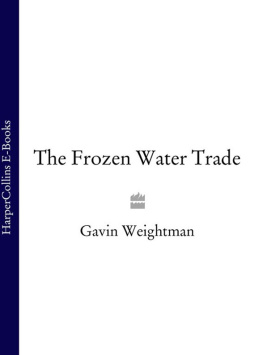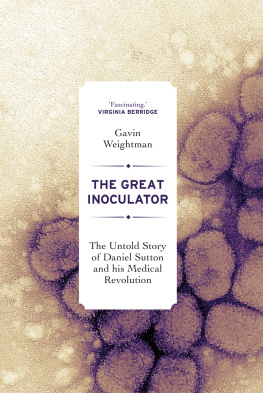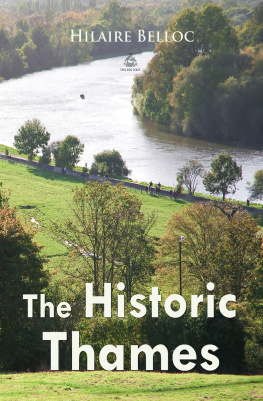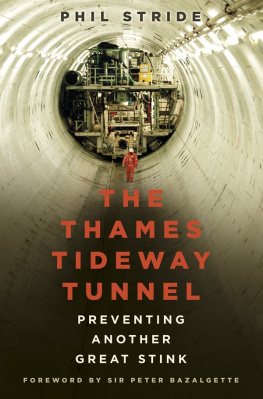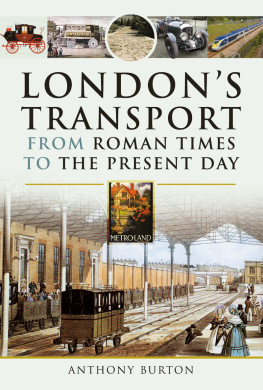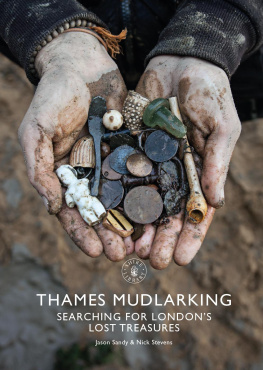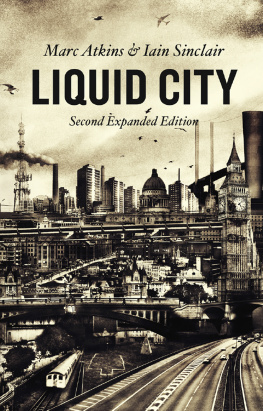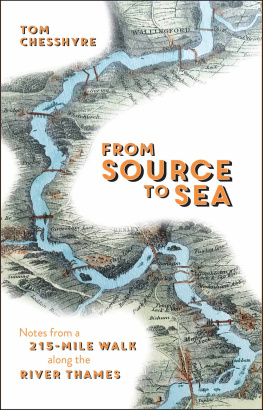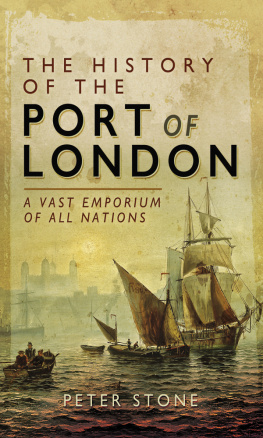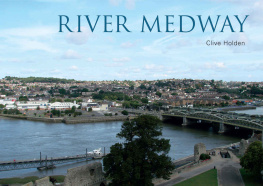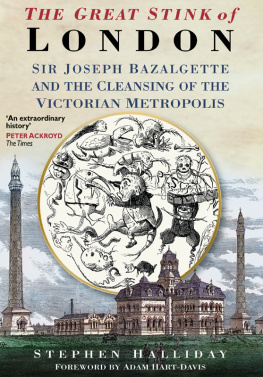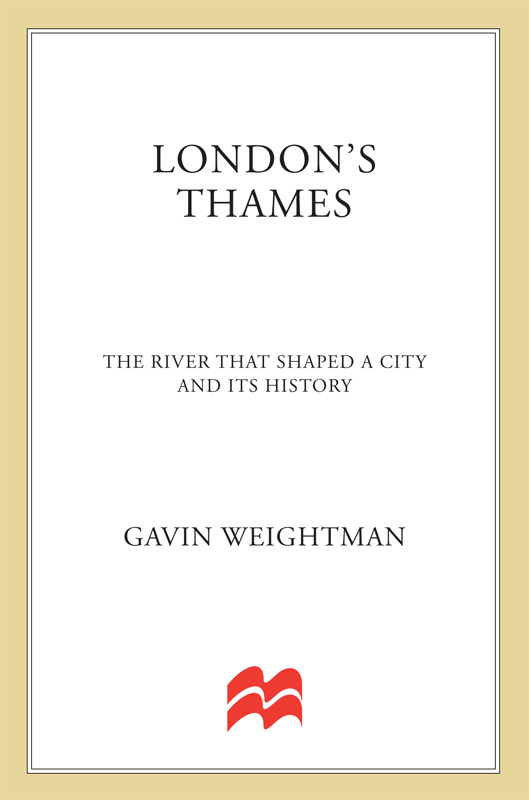
The author and publisher have provided this e-book to you for your personal use only. You may not make this e-book publicly available in any way. Copyright infringement is against the law. If you believe the copy of this e-book you are reading infringes on the authors copyright, please notify the publisher at: us.macmillanusa.com/piracy.
Contents
Introduction
There is no better place to contemplate the long and fascinating history of the River Thames than the centre of the slender Millennium footbridge, now that engineers have solved the problem of its unnerving vibrations. It spans the river between St Pauls Cathedral on the north bank and the Tate Modern art gallery directly across the water to the south. Face downstream, to the east, and the view is dominated by Tower Bridge which stands astride the river like a fairy castle. Beyond it, the Thames gradually widens on its sixty-mile course to the North Sea.
Look down through the slender silver wires of the Millennium Bridge and you might see that on the swirling brown surface of the river the flotsam and jetsam is racing westwards, towards Parliament, away from the sea. The Thames, it seems, is running backwards, flowing strongly upstream. Later the river will turn, and the water level along the Embankment walls will begin to fall rapidly, revealing gravel beaches. At the turn of the tide, roughly every six hours, there are a few minutes of calm water, then the Thames is on the move again, rushing into London from the sea.
You will not see this flow of millions of gallons of water back and forth from any bridge in Paris, for the Seine is tidal only as far upstream as Rouen, and glides through the French capital in one direction only. One overwhelming historical fact about the River Thames, the significance of which is invariably overlooked by both visitors to London and Londoners themselves, is that it is tidal, all the way from its wide estuary to the lock at Teddington in Middlesex, on the western fringes of the capital.
This flow of water, running at a treacherous six or seven knots, packs enormous power which was harnessed for centuries to supply London with everything from food to building materials, right up to the age of electricity. It was the Thames tides which gave rise to the windowless monster of the Tate Modern art gallery, for it began life in 1947 as a power station, fuelled by coal shipped upriver from the north-east of England. On the north bank, St Pauls stands testimony to the power of the Thames tides. Most of the stone and timber used to build it between 1675 and 1710 came up the river, in the days when the roads in England were pot-holed tracks, when there were no canals to speak of and steam railways were a futuristic dream.
In his poem The Waste Land the American T.S. Eliot called the river a strong brown God. If that was true of the Mississippi of his childhood in St Louis, it was even more so of the Thames, which Eliot knew well from the many years he spent in London. A sailing ship could weigh anchor near the mouth of the Thames as the flood tide began, and for six hours it would be carried inland, given a free ride on the river. Leaving the Pool of London the reaches immediately below London Bridge the same ship could get a free ride back to sea on the ebb tide.
Much can be learnt about the river from this one vantage point on the new Millennium Bridge. Take another look at Tower Bridge. When was it built? 1066? Unlikely, though its architecture appears to reflect the Tower of London which it overshadows. It is often said that the Americans who, in 1967, bought the early nineteenth-century London Bridge thought they were getting Tower Bridge which looks so much more historic. Like all myths this has a point: very few landmarks instantly say London, and Tower Bridge is one of them. It is, however, little over a century old and has a steel frame structure: the stone fascia is just cladding.
Before leaving the Millennium Bridge, you might try baiting a hook with a worm and tossing your line into the river. It does not look promising, but the chances are that you will pull out a fish. Not a salmon perhaps, but certainly a silvery roach or one of the dozens of species that have returned to the river since the great clean-up in the 1960s. Faulty sewage works and bomb damage to pipes had killed nearly all life in the metropolitan reaches of the Thames by the 1950s. The first sign that the fish were coming back after a long period of refurbishment of the sewage system was the catch made by the filters of the coal-fired electricity power stations like the original Bankside, now the Tate Modern art gallery. History was repeating itself. The site on which Bankside was built had been a fish market in the fourteenth century.
Along the banks of the Thames is layer upon layer of Londons past, much of it still visible, much of it long gone. This book aims to leave no important stone unturned as it surveys the river and its historical significance in the rise and growth of London, from the Woolwich Flood Barrier in the east to Kew Bridge and Richmond Park in the west.
Its scope is limited to those reaches of the river for purely practical reasons. To include the great sweep of the river as it widens into the estuary as well as the picturesque miles above Kew Bridge would make it much too long. The focus is on London and the hope is that, while it is written with the visitor in mind, it can be read with interest by those who have not yet seen Tower Bridge or the Houses of Parliament as well as by Londoners themselves. The profound influence exerted by the Thames on the rise and growth of London is a classic study of the immense, if often underrated, importance to a citys development of rivers which today might appear to be no more than inconsequential features of the urban landscape. If the creative power of the Thames has waned, its destructive potential remains: it is still, as Eliot would have it, a strong brown God.
London-on-sea
Moored just above Tower Bridge is the Royal Navy cruiser HMS Belfast, which has been a tourist attraction for the past thirty years. It is a sizeable ship, 11,000 tons, and a reminder of something which is not very evident today London is, or was, a seaport. There was a time when this stretch of the river just below London Bridge was crammed with ocean-going vessels: such was the scene in Charles Dickenss day and it continued so long afterwards. One of the most vivid descriptions of the riverscape in the mid-nineteenth century is by that meticulous chronicler of London life, the journalist and contemporary of Dickens, Henry Mayhew:
As I stood looking down upon the river the hundred clocks of the churches around me with the golden figures on their black faces winking in the sunshine chimed the hour of two in a hundred different tones, while solemnly, above all, boomed forth the monster bell of St Pauls, filling the air for minutes afterwards with a sweet melodious moan; and scarcely had it died away than there arose from the river the sharp tinkle of four bells from the multitude of ships and steamers below. Indeed there was an exquisite charm in the different sounds that smote the ear from the busy Port of London. Now you would hear the tinkling of the distant purl-mans bell [a beer seller on the river] as in his boat he flitted in and out among the several tiers of colliers. Then would come the rattle of some chain suddenly let go; after this, the chorus of many seamen heaving at the ropes, while, high above all, would be heard the hoarse voice of someone from the shore bawling through his hands to his mate aboard a ship in the river As you looked down on the endless vista of masts that crowded each side of the river you could not help feeling how every power known to man was used to buy and diffuse the riches of every part of the world over this little island.


